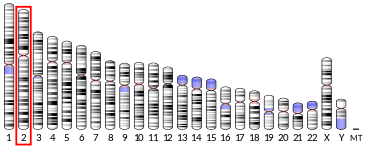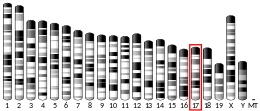NRXN1
Neurexin-1-alpha is a protein that in humans is encoded by the NRXN1 gene.[5]
Neurexins are a family of proteins that function in the vertebrate nervous system as cell adhesion molecules and receptors. They are encoded by several unlinked genes of which two, NRXN1 and NRXN3, are among the largest known human genes. Three of the genes (NRXN1-3) utilize two alternate promoters and include numerous alternatively spliced exons to generate thousands of distinct mRNA transcripts and protein isoforms. The majority of transcripts are produced from the upstream promoter and encode alpha-neurexin isoforms; a much smaller number of transcripts are produced from the downstream promoter and encode beta-neurexin isoforms. The alpha-neurexins contain epidermal growth factor-like (EGF-like) sequences and laminin G domains, and have been shown to interact with neurexophilins. The beta-neurexins lack EGF-like sequences and contain fewer laminin G domains than alpha-neurexins.[5]
Function
Neurexins are presynaptic membrane cell-adhesion molecules that bind primarily to neuroligins, proteins that have been associated with autism. Autism is characterized by a wide range of social and cognitive deficits, which are partially attributed to faulty synaptic communication between neurons.[6] This lack of communication is oftentimes tied to mutations in NRXN1. Structural variants of NRXN1a (neurexin1 alpha) are consistent with mutations predisposing autism.[7] These alpha neurexins are involved in communication through coupling mechanisms of calcium channels and vesicle exocytosis, to ensure that neurotransmitters are properly released. They are specifically required for glutamate and GABA release.[8] Implications of neurexin involvement in autism have been determined through deletion in coding exons of NRXN1a, particularly in knockout mice models. These mice showed impaired social functioning, decreased motor response in new situations, and increased aggressive behavior in males.[6] Social functioning was of major relevance for this gene and its association with autism spectrum disorder.
Genomics
The gene is found in a single copy on the short arm of chromosome 2 (2p16.3). The gene is 1,112,187 bases in length, is located on the Crick (minus) strand and encodes a protein of 1,477 amino acids (molecular weight 161.883 kDa).
Mutations of this gene that interrupt its expression have been associated with schizophrenia, autism, and intellectual disability (NRXN1 mutations and brain disorders).
Interactions
NRXN1 has been shown to interact with NLGN1.[9][10]
References
- GRCh38: Ensembl release 89: ENSG00000179915 - Ensembl, May 2017
- GRCm38: Ensembl release 89: ENSMUSG00000024109 - Ensembl, May 2017
- "Human PubMed Reference:". National Center for Biotechnology Information, U.S. National Library of Medicine.
- "Mouse PubMed Reference:". National Center for Biotechnology Information, U.S. National Library of Medicine.
- "Entrez Gene: NRXN1 neurexin 1".
- Grayton H.; Missler M.; Collier D.; Fernandes C. (2013). "Altered Social Behaviours in Neurexin 1α Knockout Mice Resemble Core Symptoms in Neurodevelopmental Disorders". PLOS ONE. 8 (6): e67114. doi:10.1371/journal.pone.0067114. PMC 3696036. PMID 23840597.
- Yan J.; Noltner K.; Feng J.; Li W.; Schroer R.; Skinner C.; Zeng W.; Schwartz C.E.; Sommer S.S. (2008). "Neurexin 1alpha structural variants associated with autism". Neurosci Lett. 438 (3): 368–70. doi:10.1016/j.neulet.2008.04.074. PMID 18490107.
- Missler M.; Zhang W.; Rohlmann A.; Kattenstroth G.; Hammer R.E.; Gottmann K.; Sudhof T.C. (2003). "Alpha-neurexins couple Ca2+ channels to synaptic vesicle exocytosis". Nature. 423 (6943): 939–948. doi:10.1038/nature01755. PMID 12827191.
- Comoletti, Davide; Flynn Robyn; Jennings Lori L; Chubykin Alexander; Matsumura Takehito; Hasegawa Hana; Südhof Thomas C; Taylor Palmer (Dec 2003). "Characterization of the interaction of a recombinant soluble neuroligin-1 with neurexin-1beta". J. Biol. Chem. United States. 278 (50): 50497–50505. doi:10.1074/jbc.M306803200. ISSN 0021-9258. PMID 14522992.
- Ichtchenko, K; Nguyen T; Südhof T C (Feb 1996). "Structures, alternative splicing, and neurexin binding of multiple neuroligins". J. Biol. Chem. UNITED STATES. 271 (5): 2676–2682. doi:10.1074/jbc.271.5.2676. ISSN 0021-9258. PMID 8576240.
Further reading
- Missler M, Südhof TC (1998). "Neurexins: three genes and 1001 products". Trends Genet. 14 (1): 20–26. doi:10.1016/S0168-9525(97)01324-3. PMID 9448462.
- Nakajima D, Okazaki N, Yamakawa H, et al. (2003). "Construction of expression-ready cDNA clones for KIAA genes: manual curation of 330 KIAA cDNA clones". DNA Res. 9 (3): 99–106. doi:10.1093/dnares/9.3.99. PMID 12168954.
- Ushkaryov YA, Petrenko AG, Geppert M, Südhof TC (1992). "Neurexins: synaptic cell surface proteins related to the alpha-latrotoxin receptor and laminin". Science. 257 (5066): 50–56. Bibcode:1992Sci...257...50U. doi:10.1126/science.1621094. PMID 1621094.
- Ichtchenko K, Nguyen T, Südhof TC (1996). "Structures, alternative splicing, and neurexin binding of multiple neuroligins". J. Biol. Chem. 271 (5): 2676–2682. doi:10.1074/jbc.271.5.2676. PMID 8576240.
- Petrenko AG, Ullrich B, Missler M, et al. (1996). "Structure and evolution of neurexophilin". J. Neurosci. 16 (14): 4360–9. doi:10.1523/JNEUROSCI.16-14-04360.1996. PMC 6578849. PMID 8699246.
- Hata Y, Butz S, Südhof TC (1996). "CASK: a novel dlg/PSD95 homolog with an N-terminal calmodulin-dependent protein kinase domain identified by interaction with neurexins". J. Neurosci. 16 (8): 2488–94. doi:10.1523/JNEUROSCI.16-08-02488.1996. PMC 6578772. PMID 8786425.
- Perin MS (1996). "Mirror image motifs mediate the interaction of the COOH terminus of multiple synaptotagmins with the neurexins and calmodulin". Biochemistry. 35 (43): 13808–13816. doi:10.1021/bi960853x. PMID 8901523.
- Nguyen T, Südhof TC (1997). "Binding properties of neuroligin 1 and neurexin 1beta reveal function as heterophilic cell adhesion molecules". J. Biol. Chem. 272 (41): 26032–26039. doi:10.1074/jbc.272.41.26032. PMID 9325340.
- Nagase T, Ishikawa K, Miyajima N, et al. (1998). "Prediction of the coding sequences of unidentified human genes. IX. The complete sequences of 100 new cDNA clones from brain which can code for large proteins in vitro". DNA Res. 5 (1): 31–39. doi:10.1093/dnares/5.1.31. PMID 9628581.
- Missler M, Hammer RE, Südhof TC (1999). "Neurexophilin binding to alpha-neurexins. A single LNS domain functions as an independently folding ligand-binding unit". J. Biol. Chem. 273 (52): 34716–34723. doi:10.1074/jbc.273.52.34716. PMID 9856994.
- Kleiderlein JJ, Nisson PE, Jessee J, et al. (1999). "CCG repeats in cDNAs from human brain". Hum. Genet. 103 (6): 666–673. doi:10.1007/s004390050889. PMID 9921901.
- Biederer T, Südhof TC (2001). "Mints as adaptors. Direct binding to neurexins and recruitment of munc18". J. Biol. Chem. 275 (51): 39803–39806. doi:10.1074/jbc.C000656200. PMID 11036064.
- Koroll M, Rathjen FG, Volkmer H (2001). "The neural cell recognition molecule neurofascin interacts with syntenin-1 but not with syntenin-2, both of which reveal self-associating activity". J. Biol. Chem. 276 (14): 10646–10654. doi:10.1074/jbc.M010647200. PMID 11152476.
- Fukuda M, Mikoshiba K (2001). "Characterization of KIAA1427 protein as an atypical synaptotagmin (Syt XIII)". Biochem. J. 354 (Pt 2): 249–57. doi:10.1042/0264-6021:3540249. PMC 1221650. PMID 11171101.
- Fukuda M, Mikoshiba K (2001). "Synaptotagmin-like protein 1-3: a novel family of C-terminal-type tandem C2 proteins". Biochem. Biophys. Res. Commun. 281 (5): 1226–1233. doi:10.1006/bbrc.2001.4512. PMID 11243866.
- Rowen L, Young J, Birditt B, et al. (2002). "Analysis of the human neurexin genes: alternative splicing and the generation of protein diversity". Genomics. 79 (4): 587–597. doi:10.1006/geno.2002.6734. PMID 11944992.
- Tabuchi K, Südhof TC (2002). "Structure and evolution of neurexin genes: insight into the mechanism of alternative splicing". Genomics. 79 (6): 849–859. doi:10.1006/geno.2002.6780. PMID 12036300.
- Nakayama M, Kikuno R, Ohara O (2003). "Protein-protein interactions between large proteins: two-hybrid screening using a functionally classified library composed of long cDNAs". Genome Res. 12 (11): 1773–1784. doi:10.1101/gr.406902. PMC 187542. PMID 12421765.









